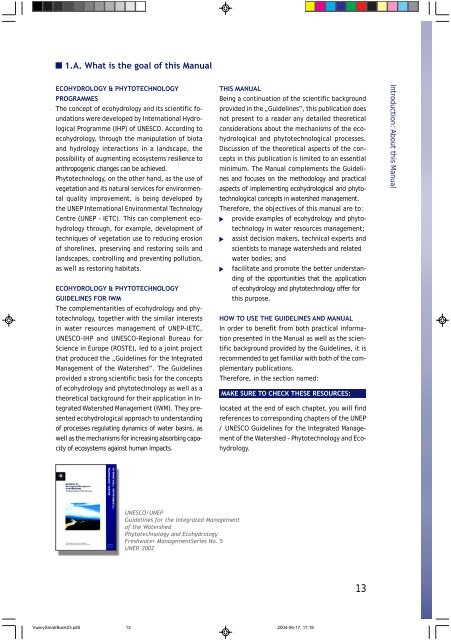Manual - International Environmental Technology Centre
Manual - International Environmental Technology Centre
Manual - International Environmental Technology Centre
Create successful ePaper yourself
Turn your PDF publications into a flip-book with our unique Google optimized e-Paper software.
1.A. What is the goal of this <strong>Manual</strong><br />
ECOHYDROLOGY & PHYTOTECHNOLOGY<br />
PROGRAMMES<br />
The concept of ecohydrology and its scientific foundations<br />
were developed by <strong>International</strong> Hydrological<br />
Programme (IHP) of UNESCO. According to<br />
ecohydrology, through the manipulation of biota<br />
and hydrology interactions in a landscape, the<br />
possibility of augmenting ecosystems resilience to<br />
anthropogenic changes can be achieved.<br />
Phytotechnology, on the other hand, as the use of<br />
vegetation and its natural services for environmental<br />
quality improvement, is being developed by<br />
the UNEP <strong>International</strong> <strong>Environmental</strong> <strong>Technology</strong><br />
<strong>Centre</strong> (UNEP - IETC). This can complement ecohydrology<br />
through, for example, development of<br />
techniques of vegetation use to reducing erosion<br />
of shorelines, preserving and restoring soils and<br />
landscapes, controlling and preventing pollution,<br />
as well as restoring habitats.<br />
ECOHYDROLOGY & PHYTOTECHNOLOGY<br />
GUIDELINES FOR IWM<br />
The complementarities of ecohydrology and phytotechnology,<br />
together with the similar interests<br />
in water resources management of UNEP-IETC,<br />
UNESCO-IHP and UNESCO-Regional Bureau for<br />
Science in Europe (ROSTE), led to a joint project<br />
that produced the „Guidelines for the Integrated<br />
Management of the Watershed”. The Guidelines<br />
provided a strong scientific basis for the concepts<br />
of ecohydrology and phytotechnology as well as a<br />
theoretical background for their application in Integrated<br />
Watershed Management (IWM). They presented<br />
ecohydrological approach to understanding<br />
of processes regulating dynamics of water basins, as<br />
well as the mechanisms for increasing absorbing capacity<br />
of ecosystems against human impacts.<br />
UNESCO/UNEP<br />
Guidelines for the Integrated Management<br />
of the Watershed<br />
Phytotechnology and Ecohydrology<br />
Freshwater ManagementSeries No. 5<br />
UNEP, 2002<br />
THIS MANUAL<br />
Being a continuation of the scientific background<br />
provided in the „Guidelines”, this publication does<br />
not present to a reader any detailed theoretical<br />
considerations about the mechanisms of the ecohydrological<br />
and phytotechnological processes.<br />
Discussion of the theoretical aspects of the concepts<br />
in this publication is limited to an essential<br />
minimum. The <strong>Manual</strong> complements the Guidelines<br />
and focuses on the methodology and practical<br />
aspects of implementing ecohydrological and phytotechnological<br />
concepts in watershed management.<br />
Therefore, the objectives of this manual are to:<br />
provide examples of ecohydrology and phytotechnology<br />
in water resources management;<br />
assist decision makers, technical experts and<br />
scientists to manage watersheds and related<br />
water bodies; and<br />
facilitate and promote the better understanding<br />
of the opportunities that the application<br />
of ecohydrology and phytotechnology offer for<br />
this purpose.<br />
HOW TO USE THE GUIDELINES AND MANUAL<br />
In order to benefit from both practical information<br />
presented in the <strong>Manual</strong> as well as the scientific<br />
background provided by the Guidelines, it is<br />
recommended to get familiar with both of the complementary<br />
publications.<br />
Therefore, in the section named:<br />
MAKE SURE TO CHECK THESE RESOURCES:<br />
located at the end of each chapter, you will find<br />
references to corresponding chapters of the UNEP<br />
/ UNESCO Guidelines for the Integrated Management<br />
of the Watershed – Phytotechnology and Ecohydrology.<br />
VwerySmatrBook03.p65 13<br />
2004-06-17, 17:18<br />
13<br />
Introduction: About this <strong>Manual</strong>

















